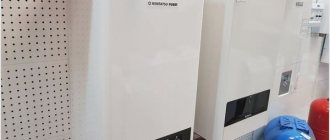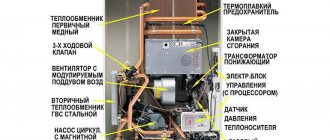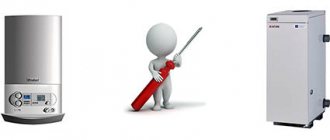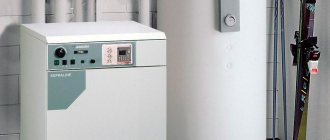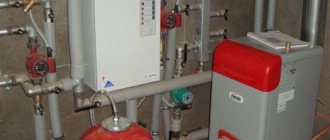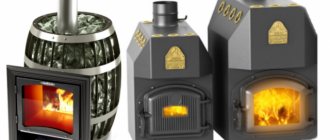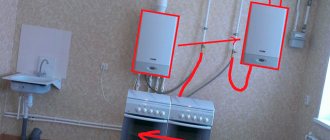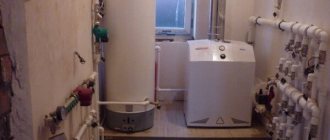What are liquefied gas boilers?
It is immediately necessary to clarify that there are no special boilers designed to operate exclusively on liquefied fuel: for this purpose, standard gas units can be used, the factory design of which allows for the possibility of conversion from natural gas to LPG and vice versa.
In addition, a boiler suitable for liquefied gas must have a low operating pressure (3-5 mbar) to ensure more complete fuel production.
What are they for and how are they used?
Organization of operation of propane gas boilers using no more than 1-3 cylinders.
Actually, of the many reasons why homeowners prefer to heat their homes with liquefied fuel, there are several main ones:
- temporary lack of supply or connection of a direct gas pipeline;
- inaccessibility or high cost of other resources in local conditions;
- the need to heat small households (40–100 m2).
The procedure for gasifying a site is often delayed (you need to save money, get permission, approve the project, etc.), so LPG comes to the rescue during such a period.
If we do not consider the option that a person lives in a coal-mining region, then cylinders are cheaper than other fuels, especially electricity.
And a liquefied gas boiler is best suited for small houses, because installing 1–3 cylinders does not take up space and does not require approval.
Design and principle of operation
The operating principle of a classic floor-mounted gas atmosphere.
An LPG boiler functions like any similar device - it burns fuel and directs energy to heat the circulating coolant (water).
But liquefied gas cannot be supplied directly. A standard injection burner has too large nozzles (holes); therefore, it is simply not designed for such fuel: gas enters in excess quantities, which leads to overheating (later to deformation) of the equipment or even to an explosion.
Therefore, initially you need to install nozzles (sprays) of a smaller diameter and connect a reducer (a device for equalizing pressure) - the pressure drop at the outlet of the cylinder will ensure the transition of fuel from liquid to gaseous form. And already in this state it enters the combustion chamber.
This is what the kit for converting the boiler to liquefied gas looks like. It can be ordered together with the boiler or purchased separately. In some models, a replacement kit is already included in the basic configuration.
The heating boiler operating on liquefied gas has no other design features: otherwise it is identical to the traditional unit.
Specifics of operation
To ensure uninterrupted heating of the home, you will have to organize a storage facility, the capacity of which must correspond to the amount of gas reserves:
- group of cylinders on a ramp - a combination of 4–15 cylinders with a volume of 0.2–0.7 m3;
- mobile gas holder – a movable tank with a capacity of 0.4–1.4 m3;
- stationary gas holder - a built-in tank with a capacity of 3–50 m3.
A group of cylinders on a ramp, together with the collectors, is placed in a strong steel box, which is placed at a distance of 1–2 m from the house or mounted to the wall of the building (if the fire resistance is above class III). Short-term supplies (1-3 cylinders) are allowed to be stored directly at home, but not in underground levels.
It is prohibited to store LPG in basements! In the event of a leak, heavy gas settles at the lower building levels, which creates a fire and explosion hazard.
An example of storing a group of cylinders in a steel box against the wall of a private house.
A mobile gas holder (minigas holder) is attached to a trailer (similar to a car) and placed no closer than 10–12 m from a residential building. To avoid condensate freezing during cold periods, the sealed container is equipped with an electric heater that is part of the general heating network.
A stationary gas tank is always installed underground - the tank is completely buried (only the lid and controls remain on top), and gas pipes are extended to the house or boiler room. Due to the walls being surrounded by soil, it does not require additional heating.
Layout of a stationary gas tank on the territory of a private house.
The minimum distance from a stationary gas tank to a residential building is determined by technical supervision authorities depending on the volume of the tank:
- distance ≥ 10 m – volume from 3 to 10 m3;
- distance ≥ 15 m – volume from 10 to 20 m3;
- distance ≥ 20 m – volume from 20 to 50 m3.
Undoubtedly, a stationary gas storage facility is the best option for ensuring continuous operation of the heating system: 1-2 refills are enough for the entire season.
In general, any of these methods of organizing a liquefied fuel storage location is considered acceptable, but subject to safety rules:
- the gas container should not be exposed to direct sunlight;
- its constant external temperature should not exceed + 43…+ 45 °C;
- Gas pipeline pipes must be laid below the soil freezing level.
For the gas boiler itself, you will also need to allocate a suitable place: 10–60 kW units can be installed in residential areas next to gas stoves and radiators, i.e. in a regular kitchen (10–15 m2), and 70–350 kW units are suitable for a room with exit to the street; it is recommended to have a separate boiler room (15–25 m2).
Poll: which option for organizing gas storage is closest to you?
Types of propane boilers
There are three types of units on the household equipment market. These are single-circuit, double-circuit and condensing boilers. They perform similar tasks, but differ in design and functionality.
Features of single-circuit devices
A boiler with one circuit is intended only for heating a room and is usually installed where water heating is solved in some alternative way.
The cost of single-circuit boilers is slightly lower than that of similar devices with two circuits. This is due to the fact that the equipment performs only a narrowly focused function - heating the home
The module is equipped with a closed combustion chamber, and during operation the boiler flame is enriched with oxygen coming from the room where the equipment is located. The materials waste during the combustion process are discharged to the street through a vertical chimney specially equipped for this purpose.
Nuances of double-circuit products
Devices equipped with two circuits effectively heat residential premises of any size and provide households with hot water. The coolant is heated by two burners, ignited using an igniter equipped with a built-in system of piezoelectric elements. When the flame lights up, the temperature sensor is activated. Upon reaching certain indicators, it gives a signal to the automation, and access to the combustion chamber is closed.
If the unit has a closed combustion chamber, for correct operation and timely removal of combustion products it is necessary to install a coaxial chimney with a forced draft. This design will ensure a uniform flow of oxygen to the wick and ensure stable combustion
Waste materials and acidic impurities leave the room through a chimney or through a ventilation outlet.
How condensing units work
A condensing-type boiler supplies both heating and hot water for domestic purposes to a living space, but does it somewhat differently than a double-circuit boiler. In a condensing device, cold water, once in a heat exchanger, is heated by a burner and hot air.
A condensing boiler is a high-tech type of equipment and is very economical in fuel consumption. The exhaust gas temperature at the burner is 40°C, and the efficiency level reaches 97%. At the same time, heat loss does not exceed 0.5%
Then half of the liquid goes into the heating system communications, and the second half goes to the taps for washing, washing and other household needs. After going through a full cycle, the water from the radiator returns to the heat exchanger and the whole procedure is repeated again.
Liquefied gas consumption
The amount of fuel spent on heating depends on the operating conditions of the device and its technical characteristics, usually power and efficiency. So, for example, according to the passport data, for the boiler JSC Zhukovsky AOGV-17.4-3 with a power of 17 kW with an efficiency of 90%, the consumption of liquefied gas is 0.7 kg/h or 1.3 l/h.
Knowing that the cost of refueling in 2021 is 12-23 rubles/l, taking the average value, you can roughly calculate the cost of heating a house over a certain period of time:
- per day (24 hours) – 1.3 × 24 = 31 l × 17 ≈ 527–558 rubles;
- per month (30 days) – 31 × 30 = 930 l × 17 ≈ 15810–16740 rubles;
- for a season (six months) – 930 × 6 = 5580 l × 17 ≈ 94860–100440 rubles.
It must be taken into account that a 50 liter cylinder actually contains 40–42 liters of propane-butane mixture: about 15–20% of the free volume is used to increase the area of gas evaporation, and overfilling leads to a decrease in its production. This means that with a flow rate of 1.3 l/h, one cylinder is enough for approximately 1.5 days.
But not everything is so bad: the numbers in the passport are given on the basis that the unit will always operate at maximum power 24/7, but in reality this only happens in severe frost. In warm weather, the boiler is active only 10–14 hours daily, i.e. the result obtained can be safely reduced by 30–50%.
How to choose a room thermostat and save up to 30% per month on heating
Reviews of domestic boilers: advantages and disadvantages
Having studied the reviews of owners of LPG boilers, you can understand that such devices are quite ambiguous - they have both strengths and obvious weaknesses.
Advantages and disadvantages of operating on reduced gas :
| pros | Minuses |
| autonomy - such devices do not depend on either the increase in utility tariffs or the stability of the gas main | refueling price - if you do not bring gas yourself, the price includes the amount spent on its transportation |
| versatility - reverse adjustment (for natural gas combustion) is possible at any time with minimal cost | regular maintenance – small jets become clogged with sulfurous substances, so they need to be cleaned frequently |
| maintaining cleanliness - bottled fuel, unlike solid fuel, does not form ash, dust, burning, smoke, etc. when burned. | high fire hazard - storing fuel reserves on site requires strict adherence to safety measures |
| environmental friendliness - the majority (91–95%) of LPG waste is carbon dioxide, which is then absorbed by plants | weather dependent - in winter there is a problem of snowdrifts that impede refueling and gearbox icing |
| simplicity of the system - the absence of complex parts ensures protection against accidents and breakdowns, as well as ease of maintenance | additional costs - the final price depends on the excavation estimate, the length of the gas pipeline, the volume of the vessel, etc. |
Users of a heating system powered by LPG are required to constantly check the remaining fuel in the connected tank. This creates certain inconveniences because it is necessary to frequently renew the contents of gas cylinders or immediately pump a sufficient amount of gas into storage.
Despite its simplicity, the refueling process requires care: the slightest carelessness when connecting the gas pipeline line can lead to a leak.
How to choose a gas boiler using liquefied gas?
It is impossible to say in absentia which liquefied gas boiler is better to choose, because its characteristics must strictly correspond to the characteristics of a particular room. Therefore, before purchasing, it is recommended to consult with specialists or independently understand the technical parameters.
Convection or condensation
The operating principle of conventional convection (efficiency 88-92%) and condensing (efficiency 104-109%) gas boilers.
The operating efficiency of an LPG consuming unit largely depends on the method of using the thermal energy released during fuel combustion:
- convection - heats the coolant using the energy obtained from direct combustion of gas, while part of the heat is lost, leaving along with the exhaust gases;
- condensing – “extracts” additional heat by cooling the smoke and condensing steam in a low-temperature heat exchanger (economizer).
Obviously, a condensing boiler is more profitable - it allows you to save 15–20% of fuel, but at the same time the device itself costs 1.5–2 times more than a conventional one.
Differences and criteria for competent selection of condensing gas boilers
Wall or floor
The fundamental difference between suspended and floor-mounted equipment lies not only in the method of its placement, but also in the structural design:
- wall-mounted models - must “fit” into a compact lightweight body; they are distinguished by a steel/copper heat exchanger, usually with more functional automation;
- floor-standing models are not limited in weight and size, therefore they can also have a cast iron heat exchanger, as well as a wider power range (10–60 kW).
Wall-mounted units are equipped with automation, a circulation pump and other energy-dependent elements - practically, the consumer is provided with a mini-heat station ready for operation. Floor-standing boilers are less independent, but many of them are completely independent of electricity.
Single-circuit or double-circuit
A visual principle of operation of double-circuit boilers with priority for hot water supply (DHW).
The number of circuits determines what tasks the gas equipment is designed to perform and what exactly the generated heat will be distributed to:
- single-circuit – intended directly for heating premises;
- double-circuit – responsible for both heating and hot water supply (DHW).
Considering the high consumption of LPG, in order to avoid unnecessary expenses, it is wise to take a single-circuit boiler and connect an indirect heating boiler to it for DHW. However, dual-circuit models also continue to be in demand.
Efficiency
Efficiency factor (efficiency) is an indicator that determines the operating efficiency of the device and the economical use of energy resources.
For boilers that mainly consume reduced fuel, the efficiency value is critical: although there are samples from 85% to 97% on sale, it makes no sense to purchase units with an efficiency below 88% - otherwise, due to the relatively high fuel consumption, the cost of gas home heating will “catch up” with electricity.
Minimum required power
To approximately calculate the boiler power, you can use a simplified formula, where for every 10 m2 of area there is 1 * kW of energy.
*approximate value taking into account a moderate climate and ceilings of 2.5–3 m.
So, for example, to heat an average house of 120 m2, located in Moscow or Moscow Region, the minimum required power of the unit will be 120 ÷ 10 × 1 = 12 kW.
We also recommend making allowances for possible severe frosts and buying a boiler with a reserve of 15–20%, i.e. for a house of 120 m2 ≈ 14 kW. Otherwise, in the cold winter, a comfortable temperature will not always be maintained, or operating at the limit will lead to premature wear of parts.
How to accurately calculate the required boiler power Individual calculation, formula and correction factors
Additional criteria
It is also worth paying attention to additional characteristics: together they will help make the gas boiler more productive and safe:
- protective kit - consists of a safety valve, draft controller, active flame sensor, air vent and backup power supply;
- functional automation - includes modules for auto-ignition, flame adjustment, self-diagnosis, mode programming and external control;
- heat and sound insulation - specially selected casing prevents heat loss (increases the efficiency of the device) and reduces the noise from the burner.
High-quality insulation helps to get rid of pops that accompany auto-ignition, crackling noises and vibrations, which is important when the boiler is indoors.
Installation equipment
To install the heating system you will need:
- a gas boiler;
- burner for liquefied (cylinder) gas and the gas cylinders themselves;
- shut-off valves and gearboxes.
Burners for bottled gas differ in their configuration from conventional ones, and are usually included in the standard configuration of gas boilers. If necessary, they can be purchased separately. Shut-off valves and the necessary gearboxes can be purchased from the company or directly at cylinder refilling stations.
Connection
A cylinder or group of cylinders is connected to the boiler through a reducer with a throughput capacity of about 2 m3 / hour. Gearboxes for home stoves are designed for lower throughput - they are not suitable for a heating system. The gas tank system may have one common reducer or a separate regulator for each cylinder. The second option is more expensive, but this is what the experts recommend - separate gearboxes provide maximum safety.
Liquefied gas cylinders cannot be installed outdoors: the cold will cause a decrease in pressure, and the heating pad may refuse to work. The ideal installation location is a warm, ventilated area
It is important to remember that bottled gas is heavier than air, and if it leaks, it will pool at the bottom, increasing the likelihood of an explosion. Therefore, the room should be chosen separately from living rooms
There should be no basements or subfloors in it!
Flow adjustment
With the help of automatic sensors and correct settings, you can reduce propane consumption rates by 3-4 times. If we are talking about a country house, then the gas consumption will be even less: during the period of absence of people, the automation will maintain the temperature at 6-9 ° C, which will reduce the propane consumption to 0.7-0.8 cylinders per week. Heating a building with liquefied gas is not the cheapest option, but in some cases it is the most optimal if there is no problem with the delivery of cylinders.
The gas boiler performs its functions perfectly even when connected to the main gas pipeline. In this case, it is quite easy to switch the equipment to a constant source of fuel supply - just change the burner.
But if there are no prospects for connecting the building to the gas pipeline, you should once again calculate the feasibility of installing a gas boiler. For a house with a total area of more than 100 m2 and maintaining a temperature of about 25 ° C, it is worth considering the possibility of installing a solid fuel boiler or another heat generator and water heating.
The best manufacturers and models: characteristics and prices
The country of manufacture determines the functionality and quality of the unit: given that it is purchased for many years to come, you should not waste your money on dubious equipment offered by the Chinese market. It is better to opt for proven options from European or Russian manufacturers.
Protherm Gepard 23 MOV
Well-known two-circuit mounted model with a power of 23 kW. It has an open combustion chamber (natural draft) and a copper plate heat exchanger: more thermally conductive and resistant to corrosion. Excellent, considering the price category, the automation allows you to fine-tune the operation of the boiler and efficiently consume fuel (max 1.9 l/h).
Manufacturer : Protherm (Proterm), Slovakia.
Bosch Gaz WBN6000-24C RN S5700
The German BOSCH with a power of 24 kW is made of higher quality materials and is not demanding on the quality of fuel and coolant. It is fully adapted to Russian conditions: it is resistant to changes in voltage, pressure and sudden cold snaps (down to – 35 °C). Economical gas consumption (max 1.5 l/h) is ensured by a modulated fan, a three-speed pump, and thermal insulation of the housing.
Manufacturer : Bosch Thermotechnik (Bosch Thermotechnik), Germany-Russia.
Buderus Logamax U072-18K
We can say that this inexpensive single-circuit boiler unit is one of the best liquefied gas boilers for heating a private home: with a power of 18 kW, it consumes fuel very moderately (max 1.5 l/h). And the built-in membrane expansion tank and three-way valve make it easy to convert it to domestic hot water. At the same time, the model is known for its high reliability, character
Manufacturer : Buderus (Buderus), Germany-Russia.
BAXI SLIM 1.150 I
The famous Italian floor-standing boiler of low power (15 kW) is known for its minimal gas consumption (max 1.1 l/h). It is already equipped from the factory with weather-compensating automation, a cast iron heat exchanger and a control module, with an integrated self-diagnosis option. And another important plus is its modest dimensions: for example, its width is only 35 cm.
Manufacturer : Baxi (Baxi), Italy.
Wester Lemax Clever-30
A domestic single-circuit wall-mounted device with a power of 30 kW, which does not depend on the availability of electricity. It can work in a system with both forced and natural coolant circulation, and continuous smooth flame modulation from 30% to 100% can significantly reduce fuel consumption (max 1.7 l/h). With such high efficiency, it is also distinguished by reliability close to European manufacturers.
The only significant drawback is the steel heat exchanger, which has a limited resource (10-14 years).
Manufacturer : Lemax (Lemax), Russia.
Prices: summary table
Comparative rating of boilers consuming liquefied fuel :
| Boiler model name | Efficiency, % | power, kWt | LPG consumption, l/h | price, rub. |
| Protherm Gepard 23 MOV | 90 | 23 | ≤ 1,9 | 51 000 |
| Bosch Gaz WBN6000-24C RN | 92 | 24 | ≤ 1,5 | 38 500 |
| Buderus Logamax U072-18K | 92 | 18 | ≤ 1,5 | 39 500 |
| BAXI SLIM 1.150 I | 90 | 15 | ≤ 1,1 | 78 000 |
| Wester Lemax Clever-30 | 90 | 30 | ≤ 1,7 | 51 000 |
Converting the boiler unit to bottled gas
Theoretically, converting the boiler to liquefied gas is not difficult: the most important thing is to replace the nozzles responsible for fuel consumption, or the entire burner. This is followed by alteration of the gas valve (in accordance with the attached operating instructions) and reconfiguration of the electronic board if the unit is automated.
But you shouldn’t interfere with the internal structure of the boiler yourself; it’s better to contact a licensed gas company. Specially trained personnel will complete the task in half an hour - maximum, while the cost of work with the purchase of all consumables will cost approximately 2.5-3.5 thousand rubles.
Conversion of a wall-mounted boiler to LPG
The procedure includes 2 operations - replacing injectors (nozzles) and adjusting the gas valve pressure in different combustion modes. To perform adjustment work you need to prepare:
- standard set of tools - screwdrivers, pliers, etc.;
- open-end wrenches and small hexagons;
- dial or electronic pressure gauge showing pressure in millibars;
- flexible connecting tube suitable for fittings on the boiler.
The first stage is partial disassembly of the unit and dismantling of the gas burner device. The goal is to get to the inner panel of the manifold, where the standard jets are screwed in. The sequence of work depends on the boiler model and generally looks like this:
- Remove the front panel of the device. On heaters of the Viessmann, Baxi, Buderus and similar brands, there is a control board behind it, which must be folded forward.
- Disconnect the ignition electrodes and pilot burner (if equipped).
- Unscrew the screws holding the main burner. Remove the part and set it aside.
- On the rear wall of the unit there is a manifold with nozzles. Change the jets by unscrewing with a flat-head screwdriver. Put the burner and electrodes back.
After replacing the jets, supply fuel to the boiler and check the quality of the connections by washing. Set the pressure on the reducer to 36-40 mbar (the exact value is indicated in the heat generator’s data sheet) and begin adjustment.
To check the tightness of the joint, apply soap suds with a sponge.
The second stage - setting up the gas boiler is carried out in the following order:
- Find 2 diagnostic fittings and an adjusting element located directly on the valve. The adjustment bolt is made in the form of a hexagon with a screw or a second hexagon inside (depending on the model of the device).
- Unscrew the screw - plug from the lower fitting, connect the pressure gauge tube and measure the inlet gas pressure. Compare the indicator with the norm prescribed in the instructions. If the value is lower than required, open the valves of 2-3 propane tanks.
- Switch the hose to the upper diagnostic fitting and start the boiler at 100% power. Use the large external hexagon to adjust the pressure for this operating mode. See the data sheet for the norm; usually the indicator is in the range of 22-28 mbar.
- Switch the heat generator to minimum power mode and repeat the adjustment by turning the internal hexagon or screw. Be sure to hold the external regulator with a key.
- Check the operation of the unit in heating and hot water heating modes. Reassemble the boiler in reverse order.
Watch this video on YouTube
Why is it important to study the operating instructions for the product? First, you need to find out the adjustment parameters
Secondly, in some models of thermal units, for example, Daewoo, there is a special switch on the control board; you don’t have to connect a pressure gauge and turn the screws at all.
On older atmospheric models equipped with a pilot burner, the wick flame may need to be adjusted. On propane, the pilot light burns hotter and will waste bottled gas. Find the appropriate adjustment screw and reduce the flame to a size of 2-3 cm. By the way, the step-by-step instructions outlined are also suitable for converting gas water heaters to LPG.
Where to buy a gas boiler using liquefied gas
In Moscow and Moscow Region
- MirCli (mircli.ru/kotly-otopleniya/nastennye-gazovye-kotly/odnokoturnye-kotly) – Leningradsky Ave., 80, building G, tel. +7 (863) 303–35–06, +7 (800) 775–29–90.
- IM “Gas Boilers” (https://msk.kotel-gazoviy.ru/na-szhizhennom-gaze/) – Moscow, st. Podolskikh Kursantov, 22, tel..
In St. Petersburg
- ProTeplo (https://www.proteplo-spb.ru/products/kotly-na-szhizhennom-gaze) – st. Chugunnaya, 14, lit. K (entrance from Mendeleevskaya 5), tel. +7 (812) 241–12–06.
- TechnoDOM (https://www.teh-dom.ru/gazovye_kotly_na_sgigennom_gaze#0) – Marshal Govorova Ave., 35, BC Yellow Corner, p. 119, tel. +7 (812) 671–00–88.
In conclusion, I would like to remind you that, despite all its advantages, liquefied fuel is not a competitor to natural gas. However, if connection to the pipeline is not available, then it can be argued that an LPG boiler is the most profitable and convenient option for organizing heating of a country house.
Gas boilersBoilers
This is important to know
Only professionals can install a heating system
The safety and reliability of a gas-powered system is more important than imaginary savings. It is necessary to comply with the maintenance of the gas boiler and chimney in a timely manner; if the instructions are poor, then you can find maintenance tips and videos demonstrating maintenance on the Internet. It is important to choose not only the boiler that is optimal in terms of power, but also to properly arrange the chimney so that the entire system works efficiently and without failures; chimney problems reduce the efficiency of the heating system and the durability of the boiler. You cannot install a computer UPS on gas boilers. If the water is hard, be sure to equip the inlet into the house with a filter to soften the water, this will extend the life of the heat exchanger. The manufacturer's warranty is valid only if several requirements are met: first commissioning by service center specialists, provision of a UPS for the boiler, repairs only by licensed craftsmen.. https://www.youtube.com/embed/T7t5BqyUvhk
